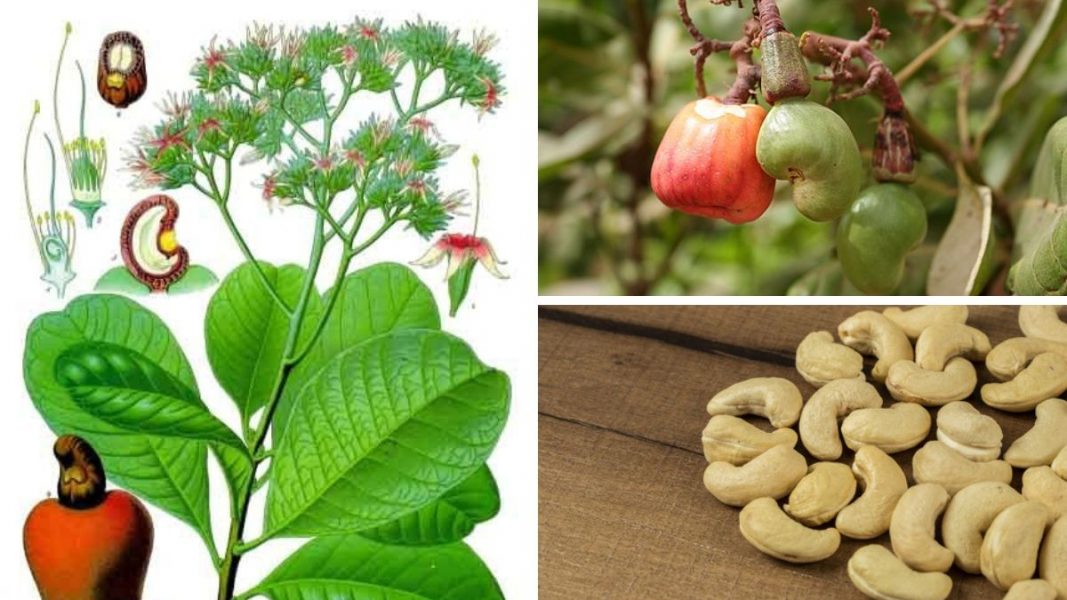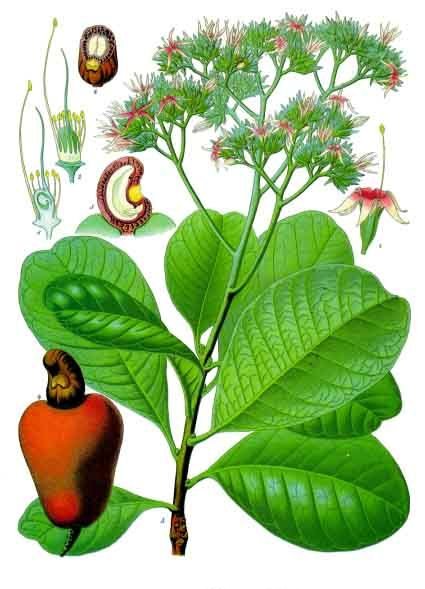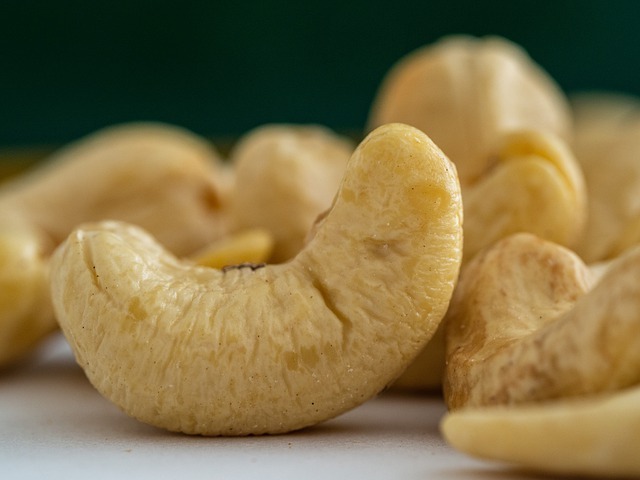
This plant has as its primary center of diversity the Amazon, Brazil being the largest producer in America, in three northeastern states: Ceará, Piauí and Rio Grande do Norte. According to Garcia (October 10, 2020)(2), it is named after the French monk and naturalist André Thevet, considering the shape of the seed; ana means “upward” and cardium, “heart”.

✅ Cashew nut taxonomy.
Cashew (Anacardium occidentale L.) belongs to the plant kingdom, division Spermatophyta, subdivision Angiospermae, class Dicotyledoneae, subclass, Archichlamideae, order Sapindales, family Anacardiaceae (which is composed of seventy genera and seven hundred species); genus Anacardium, where only the species occidentale L., has economic value due to its fleshy peduncle and edible kernel (da Silva et al., cited by Orduz and Rodríguez, 2022; Galdámez, 2004)(4),(1).

✅ Common names
This species is also known as Alcayoiba, Castaña de Cajú, Cajuil, Marañón, Nuez de la India, Merey, Pajuil, Jocote Marañón (Spanish); Cajú (Portuguese); Cashew (English), among others.
✅ Origin and distribution of Merey.
The Anacardium occidentale L. is a plant native to tropical America, whose center of origin is the Amazon basin (northeastern Brazil) and grows wild in the savannas of Colombia, Venezuela and the Guianas. It is cultivated in tropical regions of the Americas, Africa, Asia and Australia (Orduz and Rodriguez, 2022)(4).
✅ Botanical description of the plant and fruit
It is a perennial plant that reaches a height between 1.5 and 12 m approximately, with a diameter at breast height of up to 40 cm. Its crown is wide, dense, globose or irregular, with extended foliage; it has simple and alternate leaves, obovate or elliptical, 7 to 20 cm long and 4 to 12 cm wide. The trunk is thick and irregular, branched at a low height, with twisted and abundant branches. The flowers are small and aromatic with a pink to reddish tinge (SEMARNAT, n.d.)(6).
The cashew fruit consists of two parts: the pseudo-fruit and the kernel. The pseudofruit of this tree is consumed and especially its ends (the seed). Therefore, according to Galdámez (2004)(1), the true fruit of the cashew is the seed or kernel, which is approximately 2.5 to 3 cm long, and is prized for its flavor and nutritional properties.
✅ Nutritional value of cashew kernels
Each 50 grams of Cashew contains 285 calories, 9 grams of protein, 16 grams of carbohydrates and almost one gram of fiber. They also provide vitamin C and vitamins of the B group, and are also high in minerals, including magnesium, potassium, phosphorus and zinc, as well as unsaturated fatty acids (Selva, June 22, 2020)(7).

✅ Uses of almond and pseudofruit.
⚠️ Contraindications ⚠️
Cashew nuts cannot be eaten rawbecause they contain urushiol which is a toxic substance that can cause allergic reactions and even death. Therefore, the seeds should be dried in the sun and then fire roasted for disposal (Mendez, December 8, 2020)(3). Thus, cashew nuts can be consumed in their natural state, after roasting or frying the seeds.
It is also frequently used in confectionery to make nougats, chocolates and other confectionery products; it is also an ingredient used in bakery and pastry products, in the manufacture of ice cream, in granola-type cereal mixes, salads and other culinary preparations. On the other hand, Cashew has several uses in the cosmetics industry, including oils, moisturizers, and lip balms, due to its content of unsaturated fatty acids and vitamin E.
On the other hand, the pseudofruit has a high vitamin C content and is consumed as fresh fruit; it is also used in the production of juice, soft drinks, nectar, concentrate, cashew in syrup, wine, vinegar, candies, jelly, among others (Galdámez, 2004) (1).

✅ Health and beauty benefits
The consumption of cashew almonds provides multiple health benefits, being recommended for the prevention of some diseases and as a nutritional supplement, therefore it can contribute to:
- Prevention of cardiovascular diseases, as the composition of cashews control cholesterol and triglyceride levels, given their content of phytosterols, tocopherols and squalene, all antioxidant plant compounds that reduce the risk of heart disease (Penelo, 2018)(5).
- Preservation of memory and its ability to speed up brain functions. In addition, in Colombia, the root extract of the plant is used as an antidiarrheal and in Brazil, cashew leaves are chewed to keep teeth in good condition (Velasco, July 3, 2020)(9).
- Bone and muscle care. Cashew nuts are an important source of magnesium and calcium, thus preventing osteoporosis while contributing to the good condition of the nervous system and muscles, promoting relaxation and nighttime sleep, since it contains high levels of tryptophan, the amino acid precursor of serotonin synthesis, a neurotransmitter associated with general well-being (Penelo, 2018) (5).
- The pseudofruit is a good source of energy, vitamin A and riboflavin. Vitamin A promotes bone development and strengthens the immune system; riboflavin is essential for growth, as well as enzymatic functions and tissue respiration. On the other hand, the pseudofruit is an excellent source of vitamin C that contributes to the formation of collagen, which is very important for the integrity of the cellular structure of all fibrous tissues, such as connective tissue, teeth dentin, skin, tendons, among others; therefore, vitamin C is related to the recovery of wounds, fractures and hemorrhages (Sindoni, et al, 2009)(8).
- Cosmetic products derived from cashew nuts favor the care of tired and dry skin, as well as hair, preventing premature aging due to their moisturizing properties and vitamins, while providing softness and shine.
References
- Gáldamez Cáceres, A. 2004. Technical guide to cashew cultivation. San Salvador: IICA. Retrieved from http://repiica.iica.int/docs/B0216e/B0216e.pdf.
- Garcia, S. (October 10, 2020). The number of cashews you can eat in one sitting. And why they are never sold raw. El País, retrieved from https://elpais.com/buenavida/la-despensa/2020-10-10/el-numero-de-anacardos-que-puedes-comer-en-una-sola-sentada.html.
- Méndez, R. (December 08, 2020). This is the reason why you don’t eat raw cashews even if you think you do. El Español, retrieved from https://www.elespanol.com/ciencia/nutricion/20201208/razon-no-comes-anarcados-crudos-creas/540196421_0.html.
- Orduz-Rodríguez, J.O. and Rodríguez-Polanco, E. 2022. Cashew (Anacardium occidentale L.) a crop with productive potential: technological development and perspectives in Colombia. Agronomía Mesoamericana, 33(2), 28-29. Retrieved from https://dialnet.unirioja.es/servlet/articulo?codigo=8374418.
- Penelo, L. (October 25, 2018). Cashew nuts: Properties, benefits and nutritional value. Retrieved from https://www.lavanguardia.com/comer/frutos-secos/20181025/452532678398/alimentos-anacardos-propiedades-valor-nutricional-beneficios.html.
- Ministry of Environment and Natural Resources, SEMARNAT. S.f. Anacardium occidentale. Retrieved from http://www.cnf,gob.mx.
- Selva, V. (June 22, 2020).The ‘secret’ of cashews. The calorie-packed nut that helps you lose weight. Retrieved from https://www.elespanol.com/ciencia/nutricion/20200622/secreto-anacardos-fruto-seco-calorias-ayuda-adelgazar/498951065_0.html.
- Sindoni Vielma, M., Hidalgo Loggiodice, P.R., and Méndez Natera, J.R. 2009. The cashew (Anacardium occidentale L.): The fruit species of the eastern savannas of Venezuela. Revista UDO Agrícola, 9(1), 1-8. Retrieved from http://www.bioline.org.br/pdf?cg09001.
- Velasco, O. (July 03, 2020). Cashew, the exotic fruit that will benefit your memory. Retrieved from https://gourmetdemexico.com.mx/comida-y-cultura/maranon-fruta-exotica-memoria/.

Economist (Central University of Venezuela). Full professor and researcher attached to the “Edgar Abreu Olivo” Agrifood Research Center, Universidad de Los Andes. Doctor from the University of La Laguna (Spain). Award “One of the 10 most consulted authors of the Saber ULA university portal” (2005); prize in the III Essay Contest of the Central Bank of Venezuela BCvoz Economico, 2016, with the work “Theobroma cacao: transformation and consumption of the “food of the gods” in Venezuela and the world” (co-authored).
This post is also available in:
![]() Español (Spanish)
Español (Spanish)
